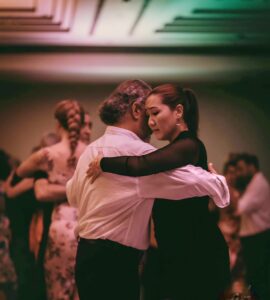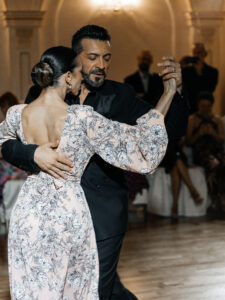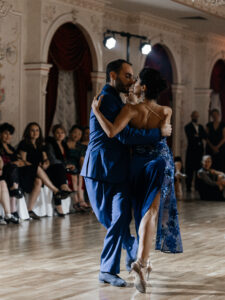ASTANA – Imagine moving to a new city where you do not know anyone. Who can you talk to? Where can you find friends? The answer might surprise you—at a social dance school. Social dancing offers a way to diversify your leisure time and adds a unique “spark” to life. It is a language all its own, one that tells stories without words.

Aiman Nakispekova, Astana Times’ reporter. Photo credit: Nakispekova’s personal archieve
Social dancing encompasses a wide variety of styles from around the globe, united not by competition but by their emphasis on connection, emotional exchange, and shared experiences. Popular styles like Argentine tango, bachata, kizomba, and salsa are just a few examples. These dances prioritize communication between partners, relying on contact, interaction, and mutual guidance. It does not matter your age, physique, or athletic ability—what truly matters is the desire to learn and enjoy the experience.
One of the most fascinating aspects of social dancing is its universality. Once you know the principles of leading and following, you can dance with anyone, anywhere in the world, even with strangers. Improvisation is at the heart of this art form, allowing dancers to connect beyond words, guided by rhythm and movement.
You might be surprised to learn that dances originating on distant continents have found vibrant communities in Kazakhstan. Foreigners visiting the country often make it a point to attend local dance events, just as Kazakh travelers abroad search for dance nights to connect with new people through this shared passion.
Two heads, four legs, one heart
Argentine tango, with a history spanning over 100 years, originated in Buenos Aires in the late 19th century. While still relatively young in Kazakhstan, this dance style is growing rapidly, with schools thriving in cities like Almaty, Astana, Pavlodar, and Atyrau. Recently, the Kazakh capital hosted its second Astana Tango Festival, attracting world-renowned tango maestros and dancers worldwide.
Tango is an improvisational dance built on steps. While it follows certain conventions, no two dances are alike—each is a unique expression of movement, connection, and musical interpretation. It is not just about the man leading and the woman following. Both partners contribute equally, creating a harmonious dialogue akin to a meaningful conversation.

Ricardo Astrada and Costanza Vieyto, tango stars from Argentina. Photo credit: Zhansaya Kuanyshbayeva
At its core, tango is about achieving unity with your partner, and moving as one. This dance is often described in the tango community as “two heads, four legs, one heart.” Beyond the physical steps, it is a journey of harmony, trust, and profound emotional connection.
Those who have watched tango in movies often associate it with passion, dramatic steps, and striking poses. But for dancers, it is much more than that. It is a deeply emotional experience—a momentary life lived in a shared embrace while the music plays. For me, tango has been more than a dance for the past decade; it’s a lifestyle with a profound philosophy and unspoken codes.
Tango enthusiasts gather at milongas—special dance evenings organized by schools or communities, where dancers dress elegantly, enjoy music and connect. For women, it is an opportunity to wear flowing dresses, while men don their best trousers and shirts. These evenings are more than just about dancing, they are about community, self-expression, and personal growth.
One of the tango’s unique rituals is the “cabeceo”, a discreet way of inviting someone to dance, which creates a sense of respect and connection in tango communities worldwide. At milongas, a man and woman make eye contact across the room. If she looks away, it is a polite refusal, sparing both parties any embarrassment. But if she holds his gaze and smiles, a nod from him seals the invitation. This silent exchange sets the stage for the deeper connection that follows on the dance floor—a conversation without words.
A lifestyle of growth
For many, tango is more than just a dance—it is a way of life. It teaches you to trust your partner, listen to your body, and fully immerse yourself in the moment. Through tango, you can experience every emotion imaginable: tenderness, passion, sadness, joy, and playfulness. Each dance is a fleeting life lived in three or four songs, leaving behind a beautiful memory.

Gianpiero Galdi and Lorena Tarantino from Italy, renowned tango celebrities. Photo credit: Zhansaya Kuanyshbayeva
Of course, not everyone immediately understands the intimacy of tango. Some may question how two strangers can share such close physical contact. In many cultures, such closeness might be considered unconventional or inappropriate. Yet, tango reveals the beauty of trust and emotional expression between two people who, even as strangers, create something extraordinary together in just a few minutes.
Tango also challenges dancers to step out of their comfort zones. Many women try leading, and men refine their skills in creating a safe and enjoyable experience for their partners. It is a process of growth and self-discovery, both on and off the dance floor.
Social dances like salsa, bachata, and kizomba, which are highly popular in Kazakhstan, bring their unique energy. Salsa offers dynamic enthusiasm, bachata conveys sensuality and romance, and kizomba captivates with its intimate flow. No matter which style you choose, social dancing creates a global community where you can find “your people” worldwide.
People come to social dancing for various reasons. Some want to master the art of movement, while others seek to improve their ability to trust, lead, or connect with others. Some find lifelong friends, and a few even discover love.
Dance is not just a physical activity—it transforms your perspective, builds confidence, and connects you to others in profound ways. Whether you are exploring tango’s emotional depths or the vibrant rhythms of salsa, social dancing is a journey that leaves no one unchanged.


